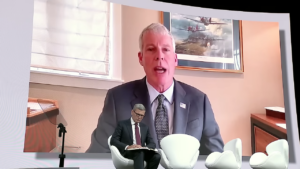As another major solar farm starts to send power to the grid in south-east Queensland, energy market analysts are forecasting that booming solar uptake on the National Electricity Market will speed up the game-changing transition to “firmed renewables.”
In a research note published on Monday, Morgan Stanley equity analysts Rob Koh and Adam Martin explain that the rapidly increasing amount of solar on the NEM will be the driving factor behind “the next major inflection” in energy markets, and perhaps sooner than most investors and even industry players are expecting.
As we reported here yesterday, 2018 was a record year for solar, and also marked the first year where large-scale projects accounted for the majority (only slightly) of the total 3,775MW of solar PV capacity added over the 12 months. And a further 3GW-plus of large-scale solar is expected to be added in 2019.
And the rooftop and commercial markets are also still booming, as power prices remain high and various new state government schemes – most notably in Victoria – drive uptake by slashing costs of installation even further.
“Solar power is hollowing out price and demand during daylight hours and changing the shape of the market,” the note says, pointing to the now well recognised shape known in the industry as the Duck Curve.

“We believe that widening intra-day spreads in price and demand will cause a major inflection in energy markets, by catalysing baseload retirement and by providing price signals for storage and faster ramp rates,” the note says.
“We believe investors will need to re-evaluate the multiple they are willing to put on baseload earnings as the world transitions to variable renewable energy (VRE) and firming,” it says.
 The comments echo those made by ITK analyst and regular RE contributor David Leitch today, in which he predicts that 2018 will be remembered as the year when wind and solar power became widely acknowledged as the forthcoming mainstream suppliers of energy into the NEM.
The comments echo those made by ITK analyst and regular RE contributor David Leitch today, in which he predicts that 2018 will be remembered as the year when wind and solar power became widely acknowledged as the forthcoming mainstream suppliers of energy into the NEM.
“Market share of wind and solar doubled to end the year at 15 per cent of the mix and future growth is assured,” Leitch says, while noting that pricing power still remains with hydro and gas.
NEM stats — week ending 13 Jan:
NEM generation by technology
• Solar: 7.8%
• Wind: 6.7%
• Hydro: 4.7%
• Gas: 6.7%
• Coal: 73.5%Renewable contribution to demand:
• NSW: 12.0%
• QLD: 10.1%
• SA: 52.6%
• TAS: 97.5%
• VIC: 19.9%
• NEM: 19.1%— OpenNEM (@OpenNem) January 14, 2019
“Although the market share of these two dispatchable fuels is declining it hasn’t yet declined to a level where price competition is manifest.”
But according to the Morgan Stanley analysis, that shift is being sped up by the massive influx of solar PV to the Australian grid, and its daily effect on the “largest and most complex machine in Australia” – the NEM.
“We think investors will increasingly need to …re-evaluate the multiple they are willing to pay for baseload earnings in a firmed renewables world,” the note says.
Meanwhile, as noted above, the Susan River Solar Farm in south-east Queensland has become the latest big solar project to start sending electricity to the grid, as the below chart from Global Roam CEO Paul McArdle illustrates.
With the addition of ESCO Pacific’s Susan River Solar Farm, there are now 15 utility-scale solar farms operating in Queensland, alone.
Of those the Ross River, Sun Metals and Darling Downs projects are 43 per cent of recent output.
Susan River, which has a nameplate capacity of 98MW, is still ramping up and recently has been running at about a 10 MW maximum output.











